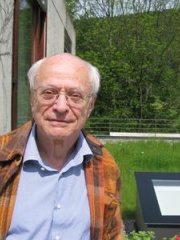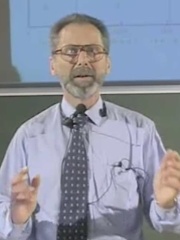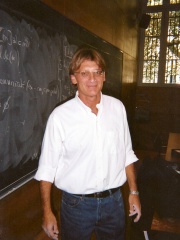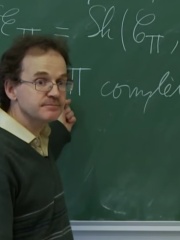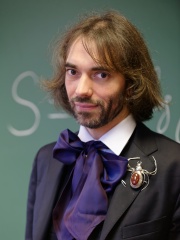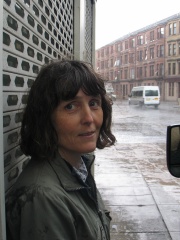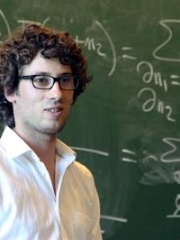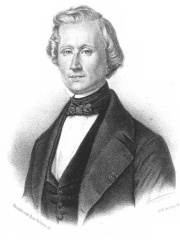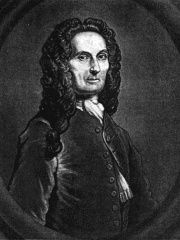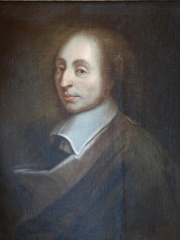
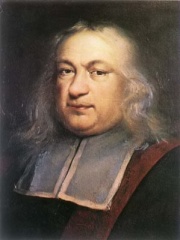
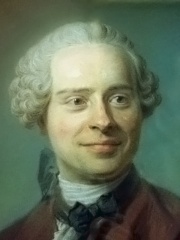
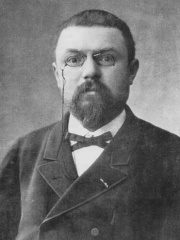
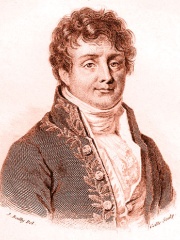
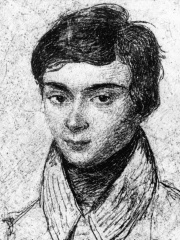
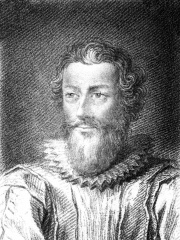

The Most Famous
MATHEMATICIANS from France
This page contains a list of the greatest French Mathematicians. The pantheon dataset contains 1,004 Mathematicians, 113 of which were born in France. This makes France the birth place of the 2nd most number of Mathematicians.
Top 10
The following people are considered by Pantheon to be the top 10 most legendary French Mathematicians of all time. This list of famous French Mathematicians is sorted by HPI (Historical Popularity Index), a metric that aggregates information on a biography's online popularity. Visit the rankings page to view the entire list of French Mathematicians.

1. Blaise Pascal (1623 - 1662)
With an HPI of 91.04, Blaise Pascal is the most famous French Mathematician. His biography has been translated into 136 different languages on wikipedia.
Blaise Pascal (19 June 1623 – 19 August 1662) was a French mathematician, physicist, inventor, philosopher, and Catholic writer. Pascal was a child prodigy who was educated by his father Étienne Pascal, a tax collector in Rouen. His earliest mathematical work was on projective geometry; he wrote a significant treatise on the subject of conic sections at the age of 16. He later corresponded with Pierre de Fermat on probability theory, strongly influencing the development of modern economics and social science. In 1642, he started some pioneering work on calculating machines (called Pascal's calculators and later Pascalines), establishing him as one of the first two inventors of the mechanical calculator. Like his contemporary René Descartes, Pascal was also a pioneer in the natural and applied sciences. Pascal wrote in defense of the scientific method and produced several controversial results. He made important contributions to the study of fluids, and clarified the concepts of pressure and vacuum by generalising the work of Evangelista Torricelli. The SI unit for pressure is named for Pascal. Following Torricelli and Galileo Galilei, in 1647 he rebutted the likes of Aristotle and Descartes who insisted that nature abhors a vacuum. He is also credited as the inventor of modern public transportation, having established the carrosses à cinq sols, the first modern public transport service, shortly before his death in 1662. In 1646, he and his sister Jacqueline identified with the religious movement within Catholicism known by its detractors as Jansenism. Following a religious experience in late 1654, he began writing influential works on philosophy and theology. His two most famous works date from this period: the Lettres provinciales and the Pensées, the former set in the conflict between Jansenists and Jesuits. The latter contains Pascal's wager, known in the original as the Discourse on the Machine, a fideistic probabilistic argument for why one should believe in God. In that year, he also wrote an important treatise on the arithmetical triangle. Between 1658 and 1659, he wrote on the cycloid and its use in calculating the volume of solids. Following several years of illness, Pascal died in Paris at the age of 39.

2. Pierre de Fermat (1601 - 1665)
With an HPI of 83.45, Pierre de Fermat is the 2nd most famous French Mathematician. His biography has been translated into 97 different languages.
Pierre de Fermat (; French: [pjɛʁ də fɛʁma]; 17 August 1601 – 12 January 1665) was a French magistrate, polymath, and above all mathematician who is given credit for early developments that led to infinitesimal calculus, including his technique of adequality. In particular, he is recognized for his discovery of an original method of finding the greatest and the smallest ordinates of curved lines, which is analogous to that of differential calculus, then unknown, and his research into number theory. He made notable contributions to analytic geometry, probability, and optics. He is best known for his Fermat's principle for light propagation and his Fermat's Last Theorem in number theory, which he described in a note at the margin of a copy of Diophantus' Arithmetica. He was also a lawyer at the parlement of Toulouse, France, a poet, a skilled Latinist, and a Hellenist.

3. Jean le Rond d'Alembert (1717 - 1783)
With an HPI of 81.57, Jean le Rond d'Alembert is the 3rd most famous French Mathematician. His biography has been translated into 87 different languages.
Jean Le Rond d'Alembert ( DAL-əm-BAIR; French: [ʒɑ̃ lə ʁɔ̃ dalɑ̃bɛʁ]; 16 November 1717 – 29 October 1783) was a French mathematician, mechanician, physicist, philosopher, and music theorist. Until 1759 he was, together with Denis Diderot, a co-editor of the Encyclopédie. D'Alembert's formula for obtaining solutions to the wave equation is named after him. The wave equation is sometimes referred to as d'Alembert's equation, and the fundamental theorem of algebra is named after d'Alembert in French.

4. Henri Poincaré (1854 - 1912)
With an HPI of 81.48, Henri Poincaré is the 4th most famous French Mathematician. His biography has been translated into 96 different languages.
Jules Henri Poincaré (UK: , US: ; French: [ɑ̃ʁi pwɛ̃kaʁe] ; 29 April 1854 – 17 July 1912) was a French mathematician, theoretical physicist, engineer, and philosopher of science. He is often described as a polymath, and in mathematics as "The Last Universalist", since he excelled in all fields of the discipline as it existed during his lifetime. He has further been called "the Gauss of modern mathematics". Due to his success in science, along with his influence in philosophy, he has also been called "the philosopher par excellence of modern science". As a mathematician and physicist, he made many original fundamental contributions to pure and applied mathematics, mathematical physics, and celestial mechanics. In his research on the three-body problem, Poincaré became the first person to discover a chaotic deterministic system which laid the foundations of modern chaos theory. Poincaré is regarded as the creator of the field of algebraic topology, and is further credited with introducing automorphic forms. He also made important contributions to algebraic geometry, number theory, complex analysis and Lie theory. He famously introduced the concept of the Poincaré recurrence theorem, which states that a state will eventually return arbitrarily close to its initial state after a sufficiently long time, which has far-reaching consequences. Early in the 20th century he formulated the Poincaré conjecture, which became, over time, one of the famous unsolved problems in mathematics. It was eventually solved in 2002–2003 by Grigori Perelman. Poincaré popularized the use of non-Euclidean geometry in mathematics as well. Poincaré made clear the importance of paying attention to the invariance of laws of physics under different transformations, and was the first to present the Lorentz transformations in their modern symmetrical form. Poincaré discovered the remaining relativistic velocity transformations and recorded them in a letter to Hendrik Lorentz in 1905. Thus he obtained perfect invariance of all of Maxwell's equations, an important step in the formulation of the theory of special relativity, for which he is also credited with laying down the foundations, further writing foundational papers in 1905. He first proposed gravitational waves (ondes gravifiques) emanating from a body and propagating at the speed of light as being required by the Lorentz transformations, doing so in 1905. In 1912, he wrote an influential paper which provided a mathematical argument for quantum mechanics. Poincaré also laid the seeds of the discovery of radioactivity through his interest and study of X-rays, which influenced physicist Henri Becquerel, who then discovered the phenomena. The Poincaré group used in physics and mathematics was named after him, after he introduced the notion of the group. Poincaré was considered the dominant figure in mathematics and theoretical physics during his time, and was the most respected mathematician of his time, being described as "the living brain of the rational sciences" by mathematician Paul Painlevé. Philosopher Karl Popper regarded Poincaré as the greatest philosopher of science of all time, with Poincaré also originating the conventionalist view in science. Poincaré was a public intellectual in his time, and personally, he believed in political equality for all, while wary of the influence of anti-intellectual positions that the Catholic Church held at the time. He served as the president of the French Academy of Sciences (1906), the president of Société astronomique de France (1901–1903), and twice the president of Société mathématique de France (1886, 1900).
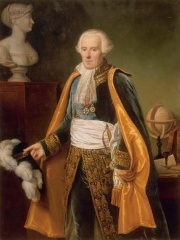
5. Pierre-Simon Laplace (1749 - 1827)
With an HPI of 81.34, Pierre-Simon Laplace is the 5th most famous French Mathematician. His biography has been translated into 103 different languages.
Pierre-Simon, Marquis de Laplace (; French: [pjɛʁ simɔ̃ laplas]; 23 March 1749 – 5 March 1827) was a French polymath, a scholar whose work has been instrumental in the fields of physics, astronomy, mathematics, engineering, statistics, and philosophy. He summarized and extended the work of his predecessors in his five-volume Mécanique céleste (Celestial Mechanics) (1799–1825). This work translated the geometric study of classical mechanics to one based on calculus, opening up a broader range of problems. Laplace also popularized and further confirmed Sir Isaac Newton's work. In statistics, the Bayesian interpretation of probability was developed mainly by Laplace. Laplace formulated Laplace's equation, and pioneered the Laplace transform which appears in many branches of mathematical physics, a field that he took a leading role in forming. The Laplacian differential operator, widely used in mathematics, is also named after him. He restated and developed the nebular hypothesis of the origin of the Solar System and was one of the first scientists to suggest an idea similar to that of a black hole, with Stephen Hawking stating that "Laplace essentially predicted the existence of black holes". He originated Laplace's demon, which is a hypothetical all-predicting intellect. He also refined Newton's calculation of the speed of sound to derive a more accurate measurement. Laplace is regarded as one of the greatest scientists of all time. Sometimes referred to as the French Newton or Newton of France, he has been described as possessing a phenomenal natural mathematical faculty superior to that of almost all of his contemporaries. He was Napoleon's examiner when Napoleon graduated from the École Militaire in Paris in 1785. Laplace became a count of the Empire in 1806 and was named a marquis in 1817, after the Bourbon Restoration.

6. Joseph Fourier (1768 - 1830)
With an HPI of 80.98, Joseph Fourier is the 6th most famous French Mathematician. His biography has been translated into 119 different languages.
Jean-Baptiste Joseph Fourier (; French: [ʒɑ̃ batist ʒozɛf fuʁje]; 21 March 1768 – 16 May 1830) was a French mathematician and physicist born in Auxerre, Burgundy and best known for initiating the investigation of Fourier series, which eventually developed into Fourier analysis and harmonic analysis, and their applications to problems of heat transfer and vibrations. The Fourier transform and Fourier's law of conduction are also named in his honour. Fourier is also generally credited with the discovery of the greenhouse effect.

7. Évariste Galois (1811 - 1832)
With an HPI of 80.32, Évariste Galois is the 7th most famous French Mathematician. His biography has been translated into 88 different languages.
Évariste Galois (; French: [evaʁist ɡalwa]; 25 October 1811 – 31 May 1832) was a French mathematician and political activist. While still in his teens, he was able to determine a necessary and sufficient condition for a polynomial to be solvable by radicals, thereby solving a problem that had been open for 350 years. His work laid the foundations for Galois theory and group theory, two major branches of abstract algebra. Galois was a staunch Republican and was heavily involved in the political turmoil that surrounded the French Revolution of 1830. As a result of his political activism, he was arrested repeatedly, serving one jail sentence of several months. For reasons that remain obscure, shortly after his release from prison, Galois fought in a duel and died of the wounds he suffered.

8. François Viète (1540 - 1603)
With an HPI of 79.70, François Viète is the 8th most famous French Mathematician. His biography has been translated into 62 different languages.
François Viète (French: [fʁɑ̃swa vjɛt]; 1540 – 23 February 1603), known in Latin as Franciscus Vieta, was a French mathematician whose work on new algebra was an important step towards modern algebra, due to his innovative use of letters as parameters in equations. Because of this, Viète is sometimes called "the father of modern algebraic notation". He was a lawyer by trade, and served as a privy councillor to both Henry III and Henry IV of France.

9. Pope Sylvester II (938 - 1003)
With an HPI of 78.50, Pope Sylvester II is the 9th most famous French Mathematician. His biography has been translated into 77 different languages.
Pope Sylvester II (Latin: Silvester II; c. 946 – 12 May 1003), originally known as Gerbert of Aurillac, was a scholar and teacher who served as the bishop of Rome and ruled the Papal States from 999 to his death. He endorsed and promoted study of Moorish and Greco-Roman arithmetic, mathematics and astronomy, reintroducing to Western Christendom the abacus, armillary sphere, and water organ, which had been lost to Latin Europe since the fall of the Western Roman Empire. He is said to be the first in Christian Europe (outside of Al-Andalus) to introduce the decimal numeral system using the Hindu–Arabic numeral system.

10. Augustin-Louis Cauchy (1789 - 1857)
With an HPI of 78.11, Augustin-Louis Cauchy is the 10th most famous French Mathematician. His biography has been translated into 76 different languages.
Baron Augustin-Louis Cauchy (UK: KOH-shee, KOW-shee, US: koh-SHEE; French: [oɡystɛ̃ lwi koʃi]; 21 August 1789 – 23 May 1857) was a French mathematician, engineer, and physicist. He was one of the first to rigorously state and prove the key theorems of calculus (thereby creating real analysis), pioneered the field complex analysis, and the study of permutation groups in abstract algebra. Cauchy also contributed to a number of topics in mathematical physics, notably continuum mechanics. A profound mathematician, Cauchy had a great influence over his contemporaries and successors; Hans Freudenthal stated: "More concepts and theorems have been named for Cauchy than for any other mathematician (in elasticity alone there are sixteen concepts and theorems named for Cauchy)." Cauchy was a prolific worker; he wrote approximately eight hundred research articles and five complete textbooks on a variety of topics in the fields of mathematics and mathematical physics.
People
Pantheon has 113 people classified as French mathematicians born between 938 and 1985. Of these 113, 8 (7.08%) of them are still alive today. The most famous living French mathematicians include Jean-Pierre Serre, Alain Connes, and Yves Meyer. The most famous deceased French mathematicians include Blaise Pascal, Pierre de Fermat, and Jean le Rond d'Alembert.
Living French Mathematicians
Go to all RankingsJean-Pierre Serre
1926 - Present
HPI: 68.44
Alain Connes
1947 - Present
HPI: 64.08
Yves Meyer
1939 - Present
HPI: 61.35
Pierre-Louis Lions
1956 - Present
HPI: 57.75
Laurent Lafforgue
1966 - Present
HPI: 54.08
Cédric Villani
1973 - Present
HPI: 53.68
Claire Voisin
1962 - Present
HPI: 52.63
Hugo Duminil-Copin
1985 - Present
HPI: 45.49
Deceased French Mathematicians
Go to all RankingsBlaise Pascal
1623 - 1662
HPI: 91.04
Pierre de Fermat
1601 - 1665
HPI: 83.45
Jean le Rond d'Alembert
1717 - 1783
HPI: 81.57
Henri Poincaré
1854 - 1912
HPI: 81.48
Pierre-Simon Laplace
1749 - 1827
HPI: 81.34
Joseph Fourier
1768 - 1830
HPI: 80.98
Évariste Galois
1811 - 1832
HPI: 80.32
François Viète
1540 - 1603
HPI: 79.70
Pope Sylvester II
938 - 1003
HPI: 78.50
Augustin-Louis Cauchy
1789 - 1857
HPI: 78.11
Urbain Le Verrier
1811 - 1877
HPI: 76.54
Abraham de Moivre
1667 - 1754
HPI: 75.96
Overlapping Lives
Which Mathematicians were alive at the same time? This visualization shows the lifespans of the 25 most globally memorable Mathematicians since 1700.

